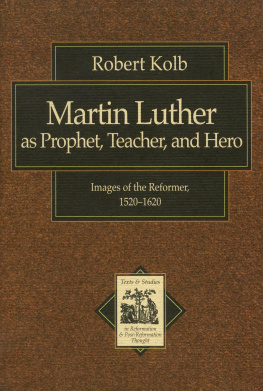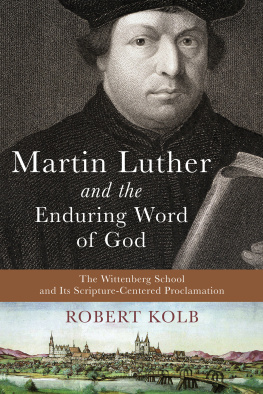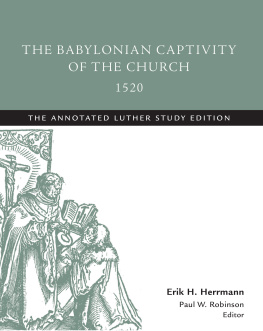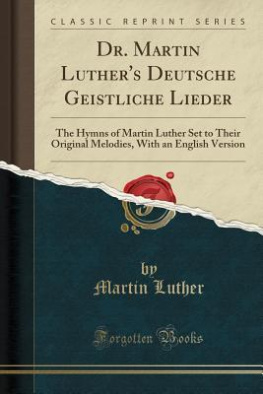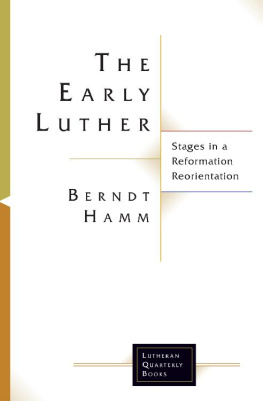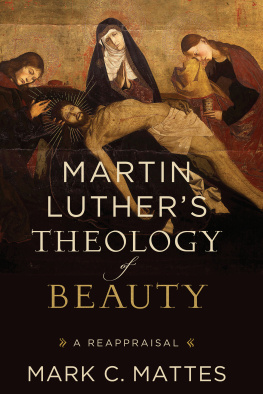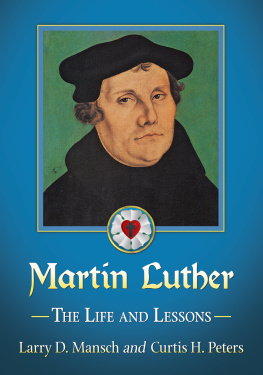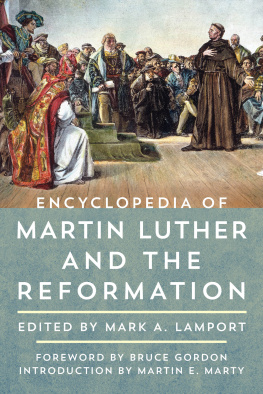Robert Kolb - Martin Luther as Prophet, Teacher, and Hero: Images of the Reformer, 1520-1620
Here you can read online Robert Kolb - Martin Luther as Prophet, Teacher, and Hero: Images of the Reformer, 1520-1620 full text of the book (entire story) in english for free. Download pdf and epub, get meaning, cover and reviews about this ebook. year: 1999, publisher: Baker Publishing Group, genre: Religion. Description of the work, (preface) as well as reviews are available. Best literature library LitArk.com created for fans of good reading and offers a wide selection of genres:
Romance novel
Science fiction
Adventure
Detective
Science
History
Home and family
Prose
Art
Politics
Computer
Non-fiction
Religion
Business
Children
Humor
Choose a favorite category and find really read worthwhile books. Enjoy immersion in the world of imagination, feel the emotions of the characters or learn something new for yourself, make an fascinating discovery.
- Book:Martin Luther as Prophet, Teacher, and Hero: Images of the Reformer, 1520-1620
- Author:
- Publisher:Baker Publishing Group
- Genre:
- Year:1999
- Rating:4 / 5
- Favourites:Add to favourites
- Your mark:
- 80
- 1
- 2
- 3
- 4
- 5
Martin Luther as Prophet, Teacher, and Hero: Images of the Reformer, 1520-1620: summary, description and annotation
We offer to read an annotation, description, summary or preface (depends on what the author of the book "Martin Luther as Prophet, Teacher, and Hero: Images of the Reformer, 1520-1620" wrote himself). If you haven't found the necessary information about the book — write in the comments, we will try to find it.
Martin Luther as Prophet, Teacher, and Hero: Images of the Reformer, 1520-1620 — read online for free the complete book (whole text) full work
Below is the text of the book, divided by pages. System saving the place of the last page read, allows you to conveniently read the book "Martin Luther as Prophet, Teacher, and Hero: Images of the Reformer, 1520-1620" online for free, without having to search again every time where you left off. Put a bookmark, and you can go to the page where you finished reading at any time.
Font size:
Interval:
Bookmark:
Texts and Studies in Reformation and Post-Reformation Thought
General Editor
Prof. Richard A. Muller, Calvin Theological Seminary
Editorial Board
Prof. Irena Backus, University of Geneva
Prof. A. N. S. Lane, London Bible College
Prof. Susan E. Schreiner, University of Chicago
Prof. David C. Steinmetz, Duke University
Prof. John L. Thompson, Fuller Theological Seminary
Prof. Willem J. van Asselt, University of Utrecht
Prof. Timothy J. Wengert, The Lutheran Theological Seminary at Philadelphia
Prof. Henry Zwaanstra, Calvin Theological Seminary
Caspar Olevianus, A Firm Foundation: An Aid to Interpreting the Heidelberg Catechism , translated, with an introduction by Lyle D. Bierma.
John Calvin, The Bondage and Liberation of the Will: A Defence of the Orthodox Doctrine of Human Choice against Pighius , edited by A. N. S. Lane, translated by G. I. Davies.
Law and Gospel: Philip Melanchthons Debate with John Agricola of Eisleben over Poenitentia, by Timothy J. Wengert.
Martin Luther as Prophet, Teacher, and Hero: Images of the Reformer, 15201620 , by Robert Kolb.
1999 by Robert Kolb
Published by Baker Academic
a division of Baker Publishing Group
P.O. Box 6287, Grand Rapids, MI 49516-6287
www.bakeracademic.com
and
Paternoster Press
P.O. Box 300, Carlisle, Cumbria CA3 0QS
United Kingdom
Ebook edition created 2012
Ebook corrections 08.11.2016
All rights reserved. No part of this publication may be reproduced, stored in a retrieval system, or transmitted in any form or by any meansfor example, electronic, photocopy, recordingwithout the prior written permission of the publisher. The only exception is brief quotations in printed reviews.
ISBN 978-1-4412-3720-0
Library of Congress Cataloging-in-Publication Data is on file at the Library of Congress, Washington, DC.
Contents
Abbreviations
| CR | Philip Melanchthon. Corpus Reformatorum. Philippi Melanchthonis opera quae supersunt omnia. Edited by Karl Bretschneider and Heinrich Bindseil. 28 vols. Halle and Braunschweig: Schwetschke, 183460. |
Ulrich Zwingli. Corpus Reformatorum. Huldreich Zwinglis Smtliche Werke. Edited by Emil Egli et al. 14 vols. (88101). Zurich: Berichthaus, 195968. | |
LW | Martin Luther. Luthers Works. 55 vols. St. Louis and Philadelphia: Concordia and Fortress, 195886. |
WA | Martin Luther. Dr. Martin Luthers Werke. 65 vols. Weimar: H. Bhlau, 18831993. |
WA Br | Martin Luther. Luthers Werke. Briefwechsel. 18 vols. Weimar: H. Bhlau, 193085. |
Illustrations
Introduction
In an attack published in 1529, Johannes Cochlaeus, Martin Luthers fierce foe and first biographer, characterized the Reformer as having seven heads. Throughout the almost five centuries since then, Luther has been depicted by friend and foe alike as having many more than seven faces. The image makers of his own age began immediately to project into public view a picture which reflected their experience of Luther. Their successors have taken the raw material of his life and thought and cast it into forms which would serve their own purposeswith varying degrees of historical accuracy. Few public figures have enjoyed and suffered the process of publicity as has Martin Luther.
Most ages seize historical personalities as clay from which they mold icons of mythical proportions to embody their values and aspirations. Into the apocalyptically charged atmosphere of late medieval Germany stumbled Martin Luther, whose career coincided with the invention of the medium of print. At the outset of his career, historical and religious conditions, medium, and man came together in a unique manner to begin fashioning a public persona which soon loomed larger than life over the German and western European ecclesiastical landscape. Read in the streets of towns and discussed in the taverns of villages, his own publications and the representations of his thought and person by other pamphleteers produced a cultural paragon which his followers in the sixteenth century put to use in several ways.
In the conclusion to his pioneering assessment of the changing views about the Reformer from Wittenberg, Horst Stephan observed that new images of Luther are always born out of a new encounter with the testimony of the original image, and they are reflections of his form in water of different depths and different hues.
Since Stephans study others have examined the interpretation of Luthers thought and work both within and outside Lutheranism. None of these, however, has focused in detail on the ways in which Luthers image and thought shaped Lutheran thinking and action during the century following his appearance on the stage of Western history. From the very beginning Luthers students and friends regarded him as a figure of more than normal proportions. Some saw him as an illustrious hero of the faith. Others regarded him as a powerful doctor of the church in line with Moses, Paul, and Augustine. Many also regarded him as a unique servant of God, a prophet and the eschatological angel who is depicted in Revelation 14 as the bearer of the gospel in the last days and whose authority could be put to use in governing and guiding the church, particularly in the adjudication of disputes over the proper and correct understanding of biblical teaching.
Without taking into account the conceptual framework of biblical humanism on the one hand, and that of late medieval apocalyptic on the other, such images seem strange to us moderns. Within the context
This inquiry will review how Luthers message and his career reshaped sixteenth-century German Lutherans views of God and human history. Three conceptions of the Reformer emerge, reflecting a variety of needs in his society, which was organized around religious ideas and ecclesiastical institutions and practices. Although all three of these conceptions appeared in the first few years of public comment on Luther, they developed in different ways as the years passed. Their influence can best be presented through a chronological tracking of their evolution as exhibited in representative writings from the pens of his disciples. To be sure, historians analyses always oversimplify: the categories are not so distinct and discrete that they can be neatly separated from each other. Thus our discussion of each motif will reveal aspects of the others.
First, for some of his followers during the subsequent decades, the Reformer functioned as a prophet who replaced popes and councils as the adjudicating or secondary authority (interpreting the primary authority, Scripture) in the life of the church. Like almost every age, the late Middle Ages were a period of crisis, and people were rethinking questions of authority in various aspects of life. Within the church Luthers challenge to the medieval papacy heightened the crisis by confirming doubts about the old religious system. Although Luther and his adherents did not discard the ancient fathers of the church nor disregard their usefulness, they did affirm the primacy of biblical authority; for them Scripture was the sole primary source of truth. The church, however, always needs a more elaborate system of determining the meaning of the biblical message; and the tradition, in the hands of popes, bishops, and councils, could no longer suffice to adjudicate differences in interpretation of the Scripture. To replace the medieval authorities who had interpreted biblical dicta regarding truth and life, Luther emerged as a prophet of God in whose words a secondary level of doctrinal authority could be found. Those who believed that this Wittenberg professor was Gods special agenta voice of divine judgment upon the corruption of the old systemwere able to ascribe such authority to him without difficulty. When the living myth had disappeared into his tomb, and could no longer adjudicate disputes by composing letters or formal faculty opinions, his writingswidely available in printwere used as a secondary authority by some of his disciples.
Next pageFont size:
Interval:
Bookmark:
Similar books «Martin Luther as Prophet, Teacher, and Hero: Images of the Reformer, 1520-1620»
Look at similar books to Martin Luther as Prophet, Teacher, and Hero: Images of the Reformer, 1520-1620. We have selected literature similar in name and meaning in the hope of providing readers with more options to find new, interesting, not yet read works.
Discussion, reviews of the book Martin Luther as Prophet, Teacher, and Hero: Images of the Reformer, 1520-1620 and just readers' own opinions. Leave your comments, write what you think about the work, its meaning or the main characters. Specify what exactly you liked and what you didn't like, and why you think so.

